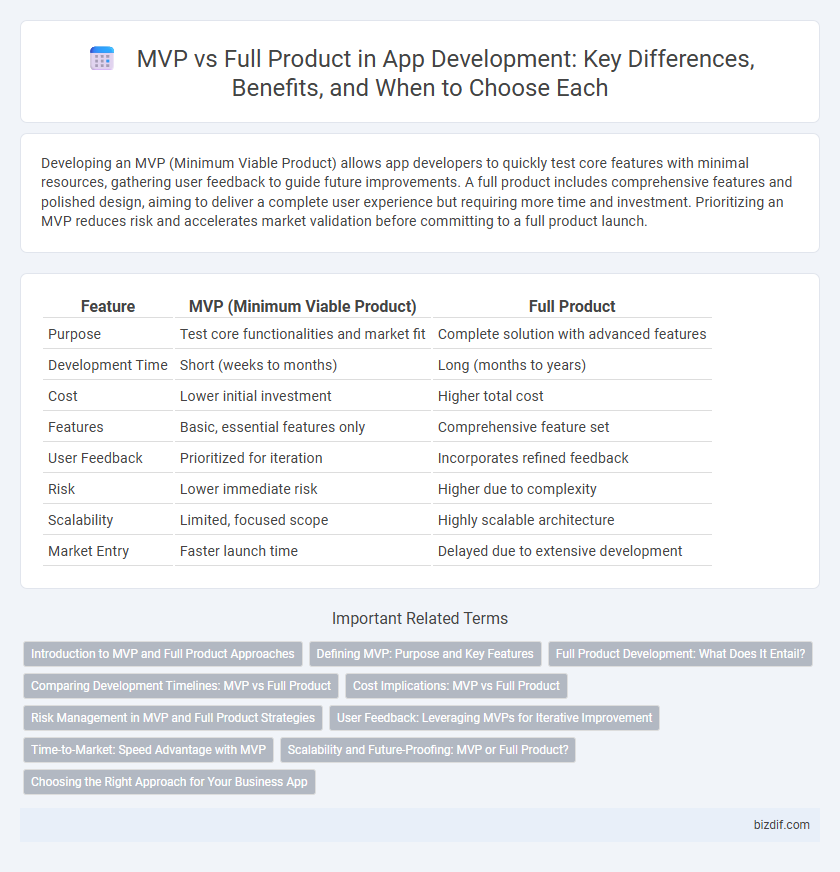Developing an MVP (Minimum Viable Product) allows app developers to quickly test core features with minimal resources, gathering user feedback to guide future improvements. A full product includes comprehensive features and polished design, aiming to deliver a complete user experience but requiring more time and investment. Prioritizing an MVP reduces risk and accelerates market validation before committing to a full product launch.
Table of Comparison
| Feature | MVP (Minimum Viable Product) | Full Product |
|---|---|---|
| Purpose | Test core functionalities and market fit | Complete solution with advanced features |
| Development Time | Short (weeks to months) | Long (months to years) |
| Cost | Lower initial investment | Higher total cost |
| Features | Basic, essential features only | Comprehensive feature set |
| User Feedback | Prioritized for iteration | Incorporates refined feedback |
| Risk | Lower immediate risk | Higher due to complexity |
| Scalability | Limited, focused scope | Highly scalable architecture |
| Market Entry | Faster launch time | Delayed due to extensive development |
Introduction to MVP and Full Product Approaches
MVP (Minimum Viable Product) focuses on launching a basic version of an app with core features to quickly validate market demand and gather user feedback. The Full Product approach involves developing a comprehensive, feature-rich app designed for a complete user experience from the start. Emphasizing MVP reduces initial investment risk and accelerates time to market, while a Full Product strategy targets immediate scalability and extensive functionality.
Defining MVP: Purpose and Key Features
Defining an MVP involves identifying the core features essential to solve the primary user problem while minimizing development time and costs. The purpose of an MVP is to validate assumptions, gather user feedback, and iterate rapidly before committing to a full product build. Key features in an MVP focus on functionality that delivers the most value, ensuring a viable and testable product version with a lean approach.
Full Product Development: What Does It Entail?
Full product development involves comprehensive planning, designing, coding, testing, and deployment to deliver a polished, market-ready application with complete features and robust scalability. It requires extensive resources, including a cross-functional team of designers, developers, QA testers, and product managers to ensure quality and user satisfaction. The process also includes continuous iteration based on user feedback, integration of advanced functionalities, and thorough documentation to support long-term maintenance and growth.
Comparing Development Timelines: MVP vs Full Product
Developing a Minimum Viable Product (MVP) typically requires 4 to 8 weeks, focusing on core features to validate ideas quickly. In contrast, building a full product often takes 4 to 6 months due to comprehensive functionality, design, and thorough testing. Prioritizing an MVP accelerates time-to-market, enabling faster user feedback and iterative improvements.
Cost Implications: MVP vs Full Product
Developing a Minimum Viable Product (MVP) significantly reduces upfront costs by focusing on core features essential for market validation, enabling faster user feedback and iterative improvements. In contrast, building a full product requires substantial investment in comprehensive features, design, testing, and scalability, increasing time-to-market and overall expenses. Prioritizing MVP development minimizes financial risk while providing actionable insights to guide subsequent full product development decisions.
Risk Management in MVP and Full Product Strategies
MVP (Minimum Viable Product) development minimizes risk by validating core features with early user feedback, reducing investment before full-scale production. Full product strategies involve higher upfront costs and complexity, increasing exposure to market and technical risks without iterative validation. Choosing MVP enables agile adjustments and better resource allocation, while full product launches require comprehensive risk mitigation plans across development, marketing, and support.
User Feedback: Leveraging MVPs for Iterative Improvement
User feedback collected through MVPs plays a crucial role in guiding iterative improvements, ensuring the final product aligns with real user needs and preferences. MVPs allow developers to test core functionalities and gather actionable insights without extensive resource investment, reducing the risk of building features that lack market demand. Continuous integration of user data helps optimize user experience and functionality, accelerating product-market fit and maximizing development efficiency.
Time-to-Market: Speed Advantage with MVP
MVP development dramatically reduces time-to-market by focusing on core features that validate product assumptions quickly, enabling faster user feedback and iterative improvement. This streamlined approach minimizes initial development hours compared to full product builds, accelerating launch timelines and reducing early-stage costs. Rapid deployment of an MVP allows startups and developers to capture market opportunities swiftly and adjust based on real user needs.
Scalability and Future-Proofing: MVP or Full Product?
Choosing between an MVP and a full product significantly affects scalability and future-proofing in app development. An MVP offers a scalable foundation by focusing on core functionalities, allowing iterative improvements and adapting to market feedback without heavy upfront costs. In contrast, a full product may provide comprehensive features initially but risks limited flexibility and higher refactoring costs when adapting to evolving technologies and user needs.
Choosing the Right Approach for Your Business App
Selecting the right approach between MVP and full product development hinges on your business goals, budget, and time-to-market priorities. An MVP allows for rapid validation of core features with minimal investment, enabling iterative improvements based on user feedback. In contrast, a full product includes comprehensive functionality tailored for a polished user experience but requires more resources and longer development cycles.
MVP vs Full Product Infographic

 bizdif.com
bizdif.com